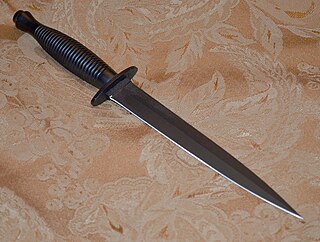
A dagger is a fighting knife with a very sharp point and usually one or two sharp edges, typically designed or capable of being used as a cutting or thrusting weapon. Daggers have been used throughout human history for close combat confrontations, and many cultures have used adorned daggers in ritual and ceremonial contexts. The distinctive shape and historic usage of the dagger have made it iconic and symbolic. A dagger in the modern sense is a weapon designed for close-proximity combat or self-defense; due to its use in historic weapon assemblages, it has associations with assassination and murders. Double-edged knives, however, play different sorts of roles in different social contexts.
A sword is an edged, bladed weapon intended for manual cutting or thrusting. Its blade, longer than a knife or dagger, is attached to a hilt and can be straight or curved. A thrusting sword tends to have a straighter blade with a pointed tip. A slashing sword is more likely to be curved and to have a sharpened cutting edge on one or both sides of the blade. Many swords are designed for both thrusting and slashing. The precise definition of a sword varies by historical epoch and geographic region.
This is a list of types of swords.

Swordsmanship or sword fighting refers to the skills and techniques used in combat and training with any type of sword. The term is modern, and as such was mainly used to refer to smallsword fencing, but by extension it can also be applied to any martial art involving the use of a sword. The formation of the English word "swordsman" is parallel to the Latin word gladiator, a term for the professional fighters who fought against each other and a variety of other foes for the entertainment of spectators in the Roman Empire. The word gladiator itself comes from the Latin word gladius, which is a type of sword.

The English language terminology used in the classification of swords is imprecise and has varied widely over time. There is no historical dictionary for the universal names, classification, or terminology of swords; a sword was simply a single-edged or double-edged knife.

A messer is a single-edged sword of the 15th and 16th century, characterised by knife-like hilt construction methods.
A stiletto is a specialized dagger with a long slender blade and needle-like point, primarily intended as a thrusting and stabbing weapon.

The Swiss dagger (Schweizerdolch) is a distinctive type of dagger used in Switzerland and by Swiss mercenaries during the 16th century. It develops from similar dagger types known as basler which were in use during the 14th and 15th centuries. The characteristic mark of the Swiss dagger are two crescent-shaped, inward-bent metal bars delimiting the hilt.

The fascine knife was a side arm / tool issued to 17th to 19th century light infantry and artillery. It served both as a personal weapon and as a tool for cutting fascines. It could be straight or curved, double edged or single edged with a sawtoothed back.
The Swiss sabre is a type of two-handed sabre design that was popular in Early Modern Switzerland.
A combat knife is a fighting knife designed for military use and primarily intended for hand-to-hand or close combat fighting.

A push dagger is a short-bladed dagger with a "T" handle designed to be grasped and held in a closed-fist hand so that the blade protrudes from the front of the fist, either between the index and middle fingers or between the two central fingers, when the grip and blade are symmetrical.
A combination weapon is a close-quarters gun hybrid combining the features of both a firearm and an edged melee weapon. Examples of gun hybrids include knife/pistols and pistol/sword combinations.

The yoroi-dōshi (鎧通し), "armor piercer" or "mail piercer", is one of the traditionally made Japanese swords that were worn by the samurai class as a weapon in feudal Japan.

An anelace was a medieval dagger worn as a gentleman's accoutrement in 14th century England.

The Swiss degen was a short sword, an elongated version of the Swiss dagger, with the same double-crescent shape of the guard. It was used as a type of side arm in the Old Swiss Confederacy and especially by Swiss mercenaries, from the first half of the 15th century until the mid 16th century. The native term used in the 15th century for this weapon was baselard. The term Schweizerdegen is first attested in 1499.

The Swiss developed a number of characteristic weapons during their period of military activity in the 15th and early 16th centuries, perfected further during the Early Modern period.













